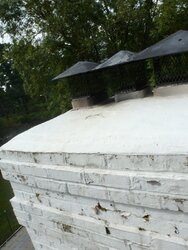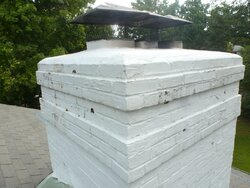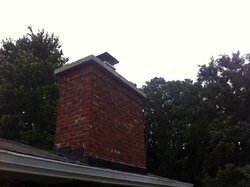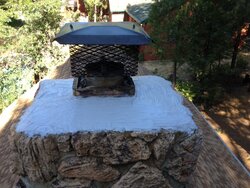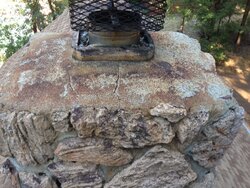Below are pictures showing our large interior chimney, with three flues. About to get our insert installed. As you can see from the broken-out mortar, we have a moisture problem. A few years ago we had a new wash/crown installed which solved our interior leak problem for awhile, but it is creeping back. (We are getting a new roof and will address possible flashing problems shortly.)
The wash now has some cracks, and we are noticing two divots where the water can puddle- not sure if that developed over time or that we just didn't notice it before.
The post below about chimney caps made me realize that if we had a single cap that covered all 3 flues, and also covered much more/nearly all of the surface area of the wash, that would help. The mason wants to put a water repellent coat on the wash.
Here are my questions. We would rather do this right the first time.
Break out the old wash and replace it?
Use the water-repellent coating +/- a more extensive combination cap?
Can a really large cap cover most/all of the wash surface area? It doesn't seem like the options on Gelco and Olympia include large flanges that cover most/all of the surface area. Any reason not to do this, such as more likely to get torn off by high winds? Could a triple cap be hinged to allow cleaning?
The wash now has some cracks, and we are noticing two divots where the water can puddle- not sure if that developed over time or that we just didn't notice it before.
The post below about chimney caps made me realize that if we had a single cap that covered all 3 flues, and also covered much more/nearly all of the surface area of the wash, that would help. The mason wants to put a water repellent coat on the wash.
Here are my questions. We would rather do this right the first time.
Break out the old wash and replace it?
Use the water-repellent coating +/- a more extensive combination cap?
Can a really large cap cover most/all of the wash surface area? It doesn't seem like the options on Gelco and Olympia include large flanges that cover most/all of the surface area. Any reason not to do this, such as more likely to get torn off by high winds? Could a triple cap be hinged to allow cleaning?


